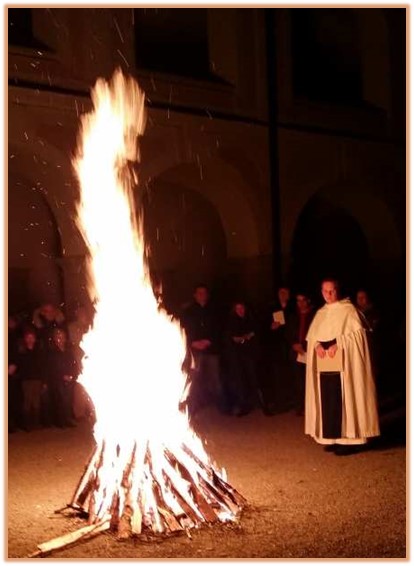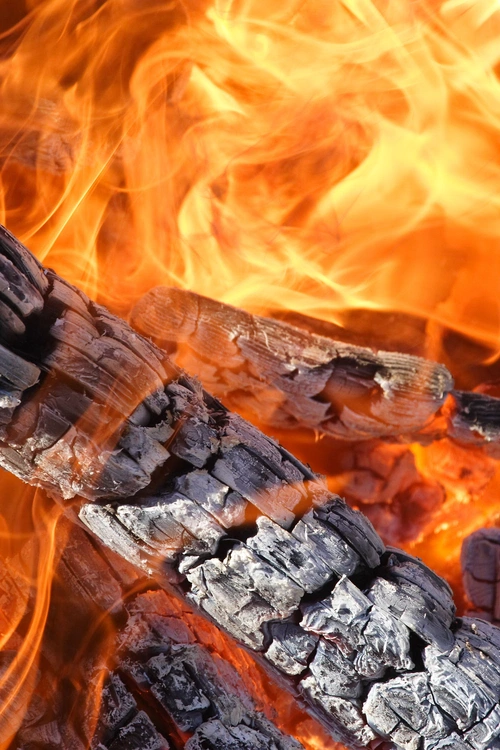Burn the old! Twice the liturgy mentions this. At the beginning of Lent and on the night of the Resurrection.
People don’t really like to be taught. They prefer to determine for themselves what they think is right. The snag is: often thoughtlessly. If they did in fact want to learn . . . . They would learn a lot from observing the world. Oh, such as fire. Isn’t it the teacher of a virtue? Prudence above all, because making use of it demands a lot. And perhaps restraint. Small and controlled, it illuminates and also heats. A big one, out of control, now it’s destructive. A beautiful image of what excess leads to. The failure of the brakes of the moral life.
In the liturgy, the flame is most often that of a candle or a lamp. Large and uncontrollable are only in biblical readings and the mouths of preachers. In the Sacred Scriptures, in the Old Testament as in the New, we hear of it as the portent of punishment; as the means of punishing. And it is both when it comes to current misfortune – e.g., foreseeing the destruction of war – or eternal misfortune – hell. The latter resonates most strongly when Jesus speaks to those who are indifferent to the fate of others (Mt 25), as He says:
Depart from me, you cursed, into the eternal fire prepared for the devil and his angels; for I was hungry and you gave me no food, I was thirsty and you gave me no drink.
There is also the fire – the fire though which to pass – synonymous with a difficult purifying trial. Perhaps most clearly in Malachi, where God says:
For he is like a refiner’s fire and like fullers’ soap; he will sit as a refiner and purifier of silver, and he will purify the sons of Levi and refine them like gold and silver, till they present right offerings to the Lord (Mal 3:2b-3).
We know: fire is needed to extract from ore or a mixture of rubbish what is noble in them. What is ignoble is burned away. What is left is the noble, the most precious. A whole gamut of Jesus’ statements follow this thought. When He declares He came to cast fire on the earth (Luke 12:49) or when He announces that everyone will be salted by fire (Mark 9:49). Fire destroys what is old and what was not noble enough to survive the fire. But by this destruction is given the possibility to build anew – with what is most valuable. To build better and meaningfully.
Aside from words relating to it, his symbolism is absent in the liturgy. Apart from the flame of candles there is still one fire: lit before the beginning of the Easter Vigil. The priest blesses this fire and then lights the Paschal Candle from it. Why, when it would be much more convenient to use a box of matches or a lighter? Ah well, because the fire has its own important symbolism.

I know how the accumulation of junk creeps up on me. This will come in useful one day. Then all of a sudden, I am overwhelmed by the clutter and lack of space – they are no longer needed, they are a distraction. For centuries such clutter has been burned (let’s not forget that what an offence it is to poison the world). It got rid of one so as to replace with another, better one. And sometimes bad memories are burned in the fire – photographs, things left by ones who were close and are now enemies. Just trying to start over again. And likewise, when there is a housefire. Clearly a misfortune. However, it also means starting anew; but this time only with what survived the fire. Which in practice is sometimes only with what is spiritually valuable.
It is precisely to this symbolism that the fire lit beside the church on the Easter Vigil alludes to. The old – often including last years palms from Palm Sunday – are destroyed. Only ashes are left. But this fire fed on the destruction of the old, permits a new beginning; allows a new candle to be lit, from which other candles gathered in the church are lit. And into the darkness comes light. Destruction of the old, a new beginning – this is the symbolism of the “paschal fire”.
From this symbolism is associated the symbol of ashes. In the Bible it is often presented as something accompanying repentance – sitting in ashes, sprinkling ashes on the head, or even eating ashes. And so, it is when we use it in the liturgy – also once a year. On the day beginning Lent: “Remember you are dust and to dust you will return” – the priest says then. Or “Repent and believe the Gospel”. Both these different statements have one common denominator – a call to penance and conversion (understood as metanoia, to change the way of thinking) as a beginning. For which the symbol is ashes.
Why? Ashes, of course, are a sign of mortification that accompanies penance. You don’t need to sit in them nor eat them to know what it’s about: even a delicate smudge of them on the forehead gives us a feeling of discomfort such that we want to clean it of as soon as possible. But of how they have been made – by burning in fire – they also become, as mentioned, a symbol of a new beginning.

On the one hand a reminder – everything someday will decay, so we need to take care of what has lasting value. On the other hand, it is a challenge: what in my past life disturbs me, bothers me, spoils my peace of mind, as these ashes on my forehead do. But that was before. It was the past. How to try and build my today is important. And what to plan for now.
